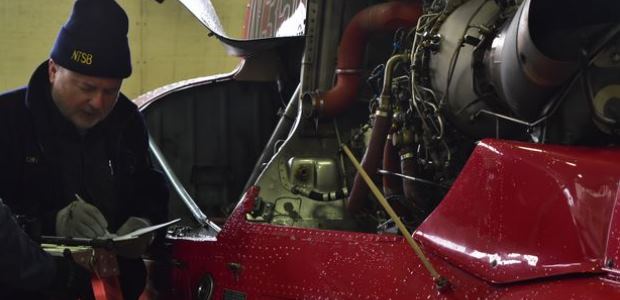
Urgent NTSB Safety Recommendation Follows Liberty Helicopters Crash
The agency's March 19 recommendation seeks an FAA ban on flights using unsafe passenger harness systems.
The National Transportation Safety Board on March 19 urged the Federal Aviation Administration to ban commercial flights using passenger harness systems that do not allow for easy release during emergencies. NTSB's urgent recommendation stems from its investigation of the March 11 crash in New York City's East River of a Liberty Helicopters Airbus AS350B2 helicopter. The helicopter plummeted into the river during an autorotation maneuver after the pilot reported a loss of engine power, and the aircraft then rolled over. The pilot, who was not wearing a harness, only manufacturer-installed lap and shoulder belts, escaped with minor injuries, but all five passengers drowned.
The harness system in the helicopter was the reason, according to NTSB.
"While we applaud the FAA's intention to move forward on banning these types of doors-off flights, the FAA has not outlined how or when they plan to take action,"’ said NTSB Chairman Robert L. Sumwalt, "and definitive action needs to be taken."
NTSB's announcement of the recommendation explained how the harness system worked:
"The additional harness system consisted of a nylon fall-protection harness tethered via a lanyard to the helicopter. The harnesses allowed passengers to move securely within the helicopter, including sitting in the door sill, while airborne. The harness system was not installed by the helicopter manufacturer; it was comprised of off-the-shelf components that were provided to the passengers by FlyNYON, the company that sold the experience to the passengers. Under normal circumstances at the conclusion of each flight, FlyNYON personnel would release a locking carabiner located on the back of the passengers' harnesses.
Despite being given a briefing on how to remove these additional harnesses using a provided cutting tool, none of the passengers were able to escape after the helicopter rolled over into the water. The pilot's manufacturer-installed restraint system was required to comply with 14 CFR section 27.785(c), which states that 'Each occupant's seat must have a combined safety belt and shoulder harness with a single point release.' The harness system provided to the passengers on the accident flight was not evaluated by the FAA."
NTSB noted that it has a longstanding concern about safe egress for passengers aboard helicopters, citing a 2008 helicopter accident where it found three of the surviving passengers' unfamiliarity with the type of buckles on the restraints in the helicopter significantly hindered their ability to release those restraints when they attempted to evacuate the cabin. In this 2008 accident, passengers did receive a briefing that described how to operate the rotary restraint, but the surviving passengers said they became confused with its release when the accident occurred.
FAA said in a series of three March 16 tweets that it will order no more "doors off" helicopter operations that involve restraints that cannot be released quickly in an emergency and will conduct a top to bottom review of its rules governing these flights to examine any potential misapplication that could create #safety gaps for passengers.